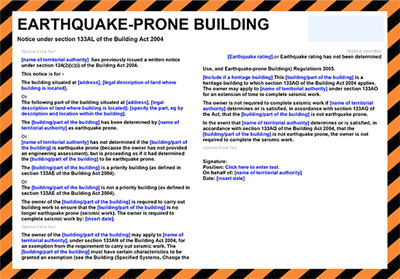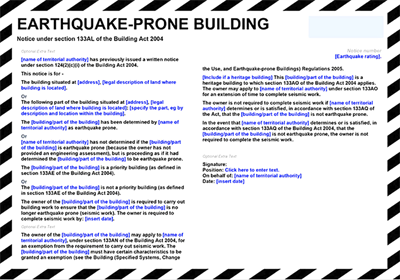Earthquake Prone Buildings
New Earthquake-Prone Buildings legislation
From 1 July 2017, there is a nationally consistent approach to the assessment and management of earthquake-prone buildings, along with a standardised notice and national public register of earthquake-prone buildings.
Check Building (Earthquake-prone Buildings) Amendment Act 2016.
How does the system work?
The system for managing earthquake-prone buildings targets buildings and parts of buildings that pose the greatest risk to public safety or other property in a moderate earthquake event.
Find out more about Managing earthquake-prone buildings.
Under the new system for managing earthquake-prone buildings territorial authorities, engineers and building owners have key roles to play:
- Territorial Authorities (TA) identify potentially earthquake-prone buildings
- Owners who are notified by their territorial authority must obtain engineering assessments of the building carried out by suitably qualified engineers
- Territorial Authorities determine whether buildings are earthquake-prone, assign ratings, issue notices and publish information about the buildings in a public register
- Owners are required to display notices on their building and to remediate their building.
There are set time frames, based on the seismic risk of the area you are in. Waitaki District is unique in that it has areas of high, medium and low-risk zones, therefore the timeframes for response actions in this district are reduced.
Identifying potentially Earthquake-Prone Buildings
Territorial authorities (local councils) are required to identify potentially earthquake-prone buildings. The EPB methodology sets out how to do this.
Find out more about the process of identifying potentially earthquake-prone buildings
Assessing potentially Earthquake-Prone Buildings
When a territorial authority identifies a building as potentially earthquake-prone, the building owner is required to provide an engineering assessment for their building within 12 months from the date they are notified. The building owner can apply for one extension of up to 12 months in certain circumstances.
Find out more about assessing potentially earthquake-prone buildings
Deciding if a building is Earthquake-Prone
Territorial authorities determine whether or not a building or part is earthquake prone. They normally make this decision after the building has been identified as potentially earthquake-prone and assessed by an engineer.
The following profile categories are used to identify potentially earthquake-prone buildings:
Category
|
Description |
| Category A |
Unreinforced masonry buildings |
| Category B |
Pre-1976 buildings that are either three or more storeys or 12 metres or greater in height above the lowest ground level (other than unreinforced masonry buildings in Category A) Pre-1976 buildings that are either three or more storeys or 12 metres or greater in height above the lowest ground level (other than unreinforced masonry buildings in Category A) |
| Category C |
Pre-1935 buildings that are one or two storeys (other than unreinforced masonry buildings in Category A) |
A key criteria for determining whether a building is earthquake-prone is whether the building or any element of it scores less than 34% when assessed against the National Building Standard (NBS).
Find out more:
Priority Buildings
Priority buildings are certain types of buildings in high and medium seismic risk areas that are considered to present a higher risk because of their construction, type, use or location. They may be buildings that are considered to pose a higher risk to life safety or buildings that are critical to recovery in an emergency.
Priority buildings need to be identified and remediated within half the time allowed for other buildings in the same seismic risk areas.
Find more information about the Guidance for Priority Building.
Strategic routes and priority thoroughfares
To identify priority buildings we must first identify priority thoroughfares and strategic routes.
A thoroughfare may warrant prioritising due to it’s high pedestrian and vehicular movements, and if it is at risk if an Unreinforced Masonry Building (URM) was to collapse on it during an earthquake.
A strategic route may warrant prioritisation if the route would be blocked should a URM collapse on it during an earthquake, preventing emergency response. These strategic routes are routes for emergency services to gain access after an event, and are essential for a number of reasons, most importantly saving lives. Buildings impeding a strategic transport route in an earthquake could delay an emergency response to the detriment of the community (I.E. loss of life, if access to emergency care is not possible).
Please see the maps below for priority thoroughfares areas (maked in blue) and strategic routes (marked in Red) in the Waitaki District.
Waitaki District Area - Seismic Risk Areas (MBIE)

Townships maps
- Duntroon - Strategic Routes and Priority Thoroughfares(JPG, 196KB)
- Hampden - Strategic Routes and Priority Thoroughfares(JPG, 544KB)
- Kakanui - Strategic Routes and Priority Thoroughfares(JPG, 529KB)
- Kurow - Strategic Routes and Priority Thoroughfares(JPG, 3MB)
- Oamaru - Strategic Routes and Priority Thoroughfares(JPG, 467KB)
- Omarama - Strategic Routes and Priority Thoroughfares(JPG, 653KB)
- Otematata - Strategic Routes and Priority Thoroughfares(JPG, 3MB)
- Palmerston - Strategic Routes and Priority Thoroughfares(JPG, 621KB)
- Waitaki district - Seismic Risk Area - MBIE(JPG, 330KB)
- Weston - Strategic Routes and Priority Thoroughfares(JPG, 383KB)
Disclosure of Earthquake-Prone status
If a territorial authority determines that a building is earthquake prone, it needs to:
- Assign an earthquake rating for that building,
- Issue an EPB notice to the owner to display prominently on the building, and
- Publish the building information on the EPB register.
There are two categories of ratings for earthquake-prone buildings prescribed in regulations. These categories determine which form of EPB notice is issued:
- Notices with an orange and black striped border are for buildings with an earthquake rating of 0% to less than 20% or where no engineering assessment has been provided and the earthquake rating has not been determined. If the building has an earthquake rating of less than 20% the risk of failure under seismic load is approximately more than 25 times the risk of failure for buildings that are 100%NBS.
- Notices with a white and black striped border are for buildings that have an earthquake rating of 20% to less than 34%. The risk of failure under seismic load is approximately 10–25 times the risk of failure for buildings that are 100%NBS.


Earthquake ratings are disclosed on the EPB notices and owners must display these in a prominent place. EPB notices also contain the deadline for owners to take action, by either strengthening or demolishing the building.
The territorial authority must also update the public EPB register to make sure that the public can access up-to-date information on which buildings have been identified as earthquake-prone and also see their earthquake rating.
Applying the outcome of the decision
Owners of earthquake-prone buildings who have received an EPB notice must take action within set time frames. The time frames depend on whether the building is a priority building.
Owners can either strengthen their building so it is no longer earthquake-prone, or demolish it to remove the risk within the time frame specified on the EPB notice. A structural engineer can provide advice on an approach that is suitable for the building.
Owners of certain heritage buildings that are determined to be earthquake-prone can apply to their territorial authority for more time – up to 10 years longer – to strengthen their buildings.
Owners of some earthquake-prone buildings may be eligible to apply for an exemption from the requirement to undertake the necessary seismic work to make their building no longer earthquake-prone.
Find out more at Guidance: Owners of Earthquake-Prone Buildings
Earthquake-Prone Buildings legislation information videos
- An Overview of the Process- Karen Marshall (Compliance Officer of Waitaki Distrct Council)
- From a Building Owners Perspective - Phillip McNicholl (The owner of Poshtel Oamaru)
- From an Architects Perspective - Gerald Carter (Catersmith Architecture + Interiors)
- From a Structural Engineers Perspective - Lou Robinson
- Funding Opportunities - Mike Frew (Heritage EQUIP)